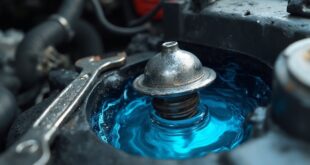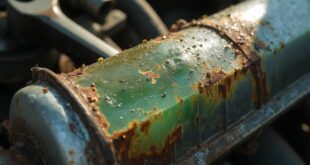If your coolant hose is leaking, there are several common causes. First, check for cracks or damage in the hose itself, which can develop over time. Insufficient clamp torque may also lead to leaks, so make sure those are tightened properly. Overpressure from the cooling system can rupture hoses, while overheating due to poor coolant flow can exacerbate the issue. Finally, watch out for corrosion in components like the radiator. Keep exploring to uncover how to fix these issues effectively.
Cracked or Damaged Hose
A cracked or damaged hose is a common culprit behind coolant leaks in your vehicle. Over time, heat and wear can take their toll, causing small cracks to form.
These minor issues can quickly escalate into larger holes, resulting in significant coolant loss. It's crucial to inspect your hoses regularly for any signs of damage.
If you notice cracks or tears, don't hesitate to replace the hose. Ignoring these issues can lead to overheating and costly repairs down the road.
Stay proactive, and keep your cooling system in top shape to guarantee your vehicle runs smoothly.
Insufficient Clamp Torque
Properly tightening hose clamps is essential for preventing coolant leaks in your vehicle. If the clamps aren't tightened to the correct torque, you risk coolant leaking at the connection points.
Here are some key points to take into account:
- Use a torque wrench for accuracy.
- Check manufacturer specifications for proper torque settings.
- Avoid overtightening to prevent hose damage.
- Inspect clamps regularly for wear or deformation.
- Make certain hoses are properly seated before tightening.
Overpressure or Overheating
When your cooling system experiences overpressure or overheating, it can lead to serious damage, including ruptured hoses. High pressure forces coolant through weak points, causing leaks and potential blowouts.
Overheating, often due to insufficient coolant flow or a malfunctioning thermostat, puts added stress on hoses, making them more susceptible to failure. Kinked hoses can further exacerbate overheating by restricting coolant circulation.
If you notice your engine temperature rising or see coolant pooling under your vehicle, address the issue immediately. Ignoring these signs not only risks further damage but also compromises your vehicle's safety and performance.
Corrosion and Faulty Components
Corrosion and faulty components in the cooling system can considerably contribute to coolant leaks. You might find that rust or corrosion in the radiator creates small openings, leading to leaks.
Additionally, faulty seals in the water pump can allow coolant to escape. To better understand the issues, keep an eye out for:
- Rust forming around connections
- Cracked water pump seals
- Discoloration on hoses
- Moisture near the radiator
- Unusual noises from the water pump
Addressing these problems promptly will help prevent further damage and guarantee your vehicle's cooling system operates efficiently.
Frequently Asked Questions
How Often Should I Inspect My Coolant Hoses?
You should inspect your coolant hoses every few months or during regular maintenance checks. Look for cracks, leaks, or signs of wear. Early detection helps prevent more significant issues and keeps your vehicle running smoothly.
What Are Signs of a Failing Hose Clamp?
You'll notice signs of a failing hose clamp when you see coolant leaks, hear hissing sounds, or find loose connections. Regularly checking your clamps helps prevent larger issues and keeps your cooling system efficient.
Can I Use Duct Tape to Fix a Coolant Leak Temporarily?
You can use duct tape as a temporary fix for a coolant leak, but it's not a long-term solution. Make sure to address the underlying issue and replace the damaged parts as soon as possible.
What Materials Are Coolant Hoses Made From?
Coolant hoses are typically made from rubber or silicone, providing flexibility and resistance to heat. They're designed to withstand pressure and temperature fluctuations, ensuring your vehicle's cooling system operates efficiently and effectively.
Are There Different Types of Coolant Hoses?
Yes, there are different types of coolant hoses. You'll find upper and lower radiator hoses, bypass hoses, and heater hoses, each designed for specific functions in your cooling system, ensuring maximum engine performance and efficiency.
 Car Service Land Coupons for Oil change, Tires, Wheel alignment, Brakes, Maintenance
Car Service Land Coupons for Oil change, Tires, Wheel alignment, Brakes, Maintenance




